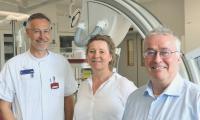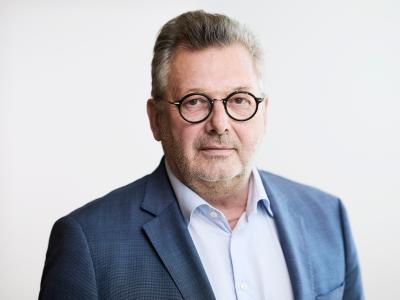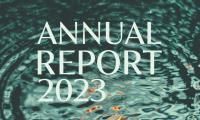From the brain to the heart: Super molecule may extend the treatment window for cardiac patients

Professor Thomas Engstrøm of the Heart Centre at Rigshospitalet hopes that Anette Sams’ discovery will one day improve heart patients’ survival rates and quality of life.
From the left: Thomas Engstrøm, Anette Sams and Jens Bukrinski.
Over the next 18 months, a DKK 5 million Frontier Grant from the Lundbeck Foundation will fuel Anette Sams’ long-standing dream of developing a life-saving drug. The Danish scientist and author hopes her discovery will revolutionise the treatment of heart attacks.
The heart ticks like clockwork all day long. And that’s how it should be. But a blood clot can suddenly put a stop to those life-giving beats. When that happens, it’s vital help is at hand – and every second counts.
Fortunately, developments and new treatments, such as balloon angioplasty and anticoagulants, have improved patient outcomes over the past decade, and survival rates have gone up significantly. But there is still a hump to get over after the emergency treatment. Often, the patient’s quality of life deteriorates, complications can sneak up on them, and they worry about new blood clots.
For decades, scientists have been searching for new treatments to prevent the inevitable biological decline that follows coronary thrombosis. And that’s where the discovery of a new super molecule comes in.

Little molecule, big potential
Behind the discovery is Danish researcher and pharmacologist Anette Sams PhD. Back in the 1990s, she studied a particular molecule with great potential. A quarter of a century on, her dream of developing a life-saving drug is alive and well, and she’s ready to begin an exciting new chapter in her biotech adventure.
The treatment is based on new versions of the neurotransmitter known as neuropeptide or calcitonin gene-related peptide (CGRP). In recent years, Sams and her team have been developing and testing these new, optimised versions of the neurotransmitter, which are more suitable for use in medicines than the naturally occurring form. If she succeeds in her mission, it could save millions of lives around the world.
‘One effect of the neurotransmitter is to dilate small blood vessels, which improves blood flow in the heart muscles after a clot. The new versions retain the ability to do this and have proven surprisingly effective in animal studies,’ says Paul E.G. Kristjansen, Senior Scientific Director at the Lundbeck Foundation and head of its special Frontier Grants programme.
Breathing life into heart tissue
The drug works by dilating the small blood vessels in the heart. It is administered as an injection that targets the heart musculature and revitalises (oxygenates) the tissue around the clot. Animal studies have shown that the treatment prevents damage before the heart fails and stops beating completely. The hope is that it will work just as well in humans, and we will conduct trials over the next few years. First, however, we have to scale the project up, and more tests will be required before the team reaches that stage.
‘Expectations are high, and if everything goes according to plan, the treatment could be revolutionary for heart patients worldwide,’ says Sams.
‘We have the patent to refine the neuropeptide, the neurotransmitter CGRP, which occurs naturally in humans. Experiments on animals have shown that it can prevent harmful effects after a blood clot in the heart and significantly extend the treatment window for patients.’
Need for new solutions
The project has received strong support since 2020 in the form of two InnoExplorer grants and an Innobooster from Innovation Fund Denmark. An accelerated entrepreneurship programme in collaboration with the Lundbeck Foundation’s BioCapital and Frontier Grants teams will take it to the next level. The programme will run over the next 18 months and hopefully secure further funding and scaling for clinical trials with patients.
‘If we are serious about helping the many patients who suffer from coronary thrombosis every year, not to mention its after-effects, we must look at new solutions. We have shown that we can exploit the unique properties of CGRP to prevent a blood clot from developing into heart failure. We need to get the drug to the market, preferably into ambulances and medical centres, where it will help patients. There’s no time to waste. We must look as soon as possible at what this treatment could mean for real people with critical heart disease,’ she adds.
A discovery 25 years in the making
Anette Sams studied the properties of CGRP in different types of blood vessels as a PhD student at the University of Copenhagen from 1997 to 2000. She discovered how CGRP can be recycled in the nerve endings that release it near the blood vessels.
‘I wondered why CGRP seems to have a different effect on the heart’s blood vessels than in other parts of the body. This raised the question of whether CGRP, administered as a drug in the right way, could be used to treat coronary thrombosis. However, the natural substance (CGRP) is completely unsuitable as a drug, as it breaks down in the body within minutes. We had to design a new version of the molecule that would last far longer. Back in the late ’90s, that was impossible – the technological know-how just didn’t exist,’ Sams explains.
It wasn’t until 2008, when researchers from New Zealand showed that long-term infusion with CGRP had a favourable effect on metabolic conditions, that Sams started the next chapter in her research.
Since then, she has been working to develop the concept in collaboration with, among others, Professor Lars Edvinsson from Rigshospitalet Glostrup. In 2021, Edvinsson received the Brain Prize for his ground-breaking work on how the CGRP neurotransmitter affects migraines. Now, it looks as if CGRP will play a key role in treating another major public health issue – acute coronary thrombosis. Naturally, the cardiologists at Rigshospitalet are, of course, delighted at the prospect.
From the brain to the heart
Professor Thomas Engstrøm has been involved in the project as a clinical advisor since 2019. He sees enormous potential in this ‘brain to heart’ treatment. And with good reason.
‘There are still regional differences in treatment and prognosis for people who suffer heart attacks. In some parts of the world, the time it takes to get them to a hospital is so long that it is often too late to save the heart. The new treatment will hopefully begin much earlier –on the spot or in the ambulance, for example. But there is also a need for treatments that improve the patients’ quality of life and their long-term prognosis after the emergency,’ says Engstrøm.
‘In animal studies, the drug works right away and continues to do so long afterwards,’ says Sams. ‘It now needs to be prepared for first-in-human studies. If all goes well, in a few years, we will start human trials aimed at complementing the excellent treatment patients receive at specialist cardiac centres like Thomas Engstrøm’s.’
The Lundbeck Foundation has awarded Anette Sams and her collaborator Jens Bukrinski a special Frontier Grant to advance their research and development work over the next 18 months. Hopefully, the project will be the start of the next big Danish life-science adventure and usher in a new era in the treatment of blood clots and heart failure.
Lundbeck Foundation Frontier Grants

The Lundbeck Foundation introduced Frontier Grants to support the consolidation and development of basic research with potential treatment. No specific limits are set for areas of disease and treatment, but originality and high scientific quality are key funding criteria.
The Foundation works closely with applicants to identify crucial activities that will help mature the project and attract venture capital to set up a new biotech company, sell the idea to big pharma – or anything in between those two scenarios.
‘Each project is unique, so we work closely with the applicant to draw up a tailor-made personal development programme and prepare them for the leap from academia to the Danish biotech industry,’ says Kristjansen.
Following a long career as a doctor, university researcher and in the pharmaceutical industry, Kristjansen joined the Lundbeck Foundation in 2022 to head up the Frontier Grants programme.
‘The Danish research institutions are veritable hives of activity and highly promising in terms of breadth and quality. So we are in no doubt that we launched our new programme at just the right time,’ he concludes.
About the Lundbeck Foundation Frontier Grants



